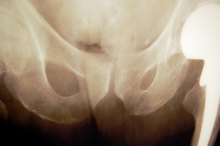What Are the Causes of Leg Pain & Waist Pain?
Numerous conditions can cause waist and leg pain. According to the MedlinePlus website, leg pain can be caused by structures within the leg itself or it can be caused by problems in other parts of the body, such as the waist or pelvic girdle. Leg and waist pain may be caused by the same condition or they may arise due to separate conditions. In some cases, leg and waist pain can be severe and debilitating.
Hip Fracture
A hip fracture can cause pain in the leg and waist, or pelvic girdle area. According to MayoClinic.com, hip fractures are serious injuries, especially among older individuals. Although a person can fracture her hip at any point, most hip fractures occur in people over the age of 65. Over time, a person's bones lose minerals and become less dense. Loss of bone mineral density makes bones, including the hip bones, more vulnerable to fracture and injury. Common signs and symptoms associated with hip fractures include severe pain in the hip and surrounding regions, inability to bear weight on the affected side, stiffness, bruising and swelling in the injured area, a shorter leg on the involved side, and an affected-side leg that's rotated outward. MayoClinic.com states that most hip fractures are caused by falls, blunt-force trauma to the hip region and decreased bone mineral density.
- A hip fracture can cause pain in the leg and waist, or pelvic girdle area.
- MayoClinic.com states that most hip fractures are caused by falls, blunt-force trauma to the hip region and decreased bone mineral density.
Sciatica
Causes of Bilateral Hip Pain in Women
Learn More
Sciatica can cause pain in the leg and waist. The American Academy of Orthopaedic Surgeons, or AAOS, states that sciatica—an impingement of the sciatic nerve, the thickest and longest nerve in the body—is usually caused by degenerative changes in the lumbar vertebrae, or lower back spinal bones, or a herniated, or bulging, spinal disc in the lower back. Sciatica most often occurs among people between the ages of 30 and 50. According to the AAOS, sciatica-related pain usually diminishes on its own over time. Common signs and symptoms associated with sciatica include pain in the low back, buttocks or back of the leg as well as numbness, tingling or muscle weakness in the calf and affected-side lower extremity. In serious cases, a person may also experience changes in bowel or bladder function. Changes in bowel or bladder function signal a medical emergency.
- Sciatica can cause pain in the leg and waist.
Polymyalgia Rheumatica
Polymyalgia rheumatica can cause leg and waist pain. According to the Vasculitis Foundation, an organization dedicated to supporting and empowering people with vascular problems through education, awareness and research, polymyalgia rheumatica manifests in approximately 50 percent of people with giant cell arteritis, which is a painful inflammatory disease of the blood vessels of the head. Polymyalgia rheumatica is characterized by pain and stiffness in muscles throughout the body. Common signs and symptoms associated with polymyalgia rheumatica include aching and morning stiffness in the shoulders, hip and leg area, neck, and mid-body; fatigue; weakness; unexplained weight loss; low-grade fever; bone and joint inflammation; and decreased active range of motion in the shoulder, neck and hip joints. The Vasculitis Foundation states that, in most cases, polymyalgia rheumatica-related symptoms will usually abate after a period of months or years.
- Polymyalgia rheumatica can cause leg and waist pain.
- The Vasculitis Foundation states that, in most cases, polymyalgia rheumatica-related symptoms will usually abate after a period of months or years.
Related Articles
References
- MedlinePlus: Leg Pain
- Mayo Clinic: Hip Fracture
- American Academy of Orthopaedic Surgeons: Sciatica
- "Questions and Answers about Polymyalgia Rheumatica and Giant Cell Arteritis." National Institute of Arthritis and Musculoskeletal and Skin Diseases. April 2010.
- Dasgupta B. et al. "2012 Provisional Classification Criteria for PolymyalgiaRrheumatica: A European League Against Rheumatism/American College of Rheumatology collaborative initiative." Arthritis & Rheumatism. April 2012. doi:10.1136/annrheumdis-2011-200329
- Docken, MD., WP. "Polymyalgia Rheumatica." American College of Rheumatology. Updated August 2009.
- Klippel J. et al. "Primer on the Rheumatic Diseases. Polymyalgia Rheumatica." Pages 404-406. Thirteenth Edition. Arthritis Foundation.
Writer Bio
Martin Hughes is a chiropractic physician, health writer and the co-owner of a website devoted to natural footgear. He writes about health, fitness, diet and lifestyle. Hughes earned his Bachelor of Science in kinesiology at the University of Waterloo and his doctoral degree from Western States Chiropractic College in Portland, Ore.









